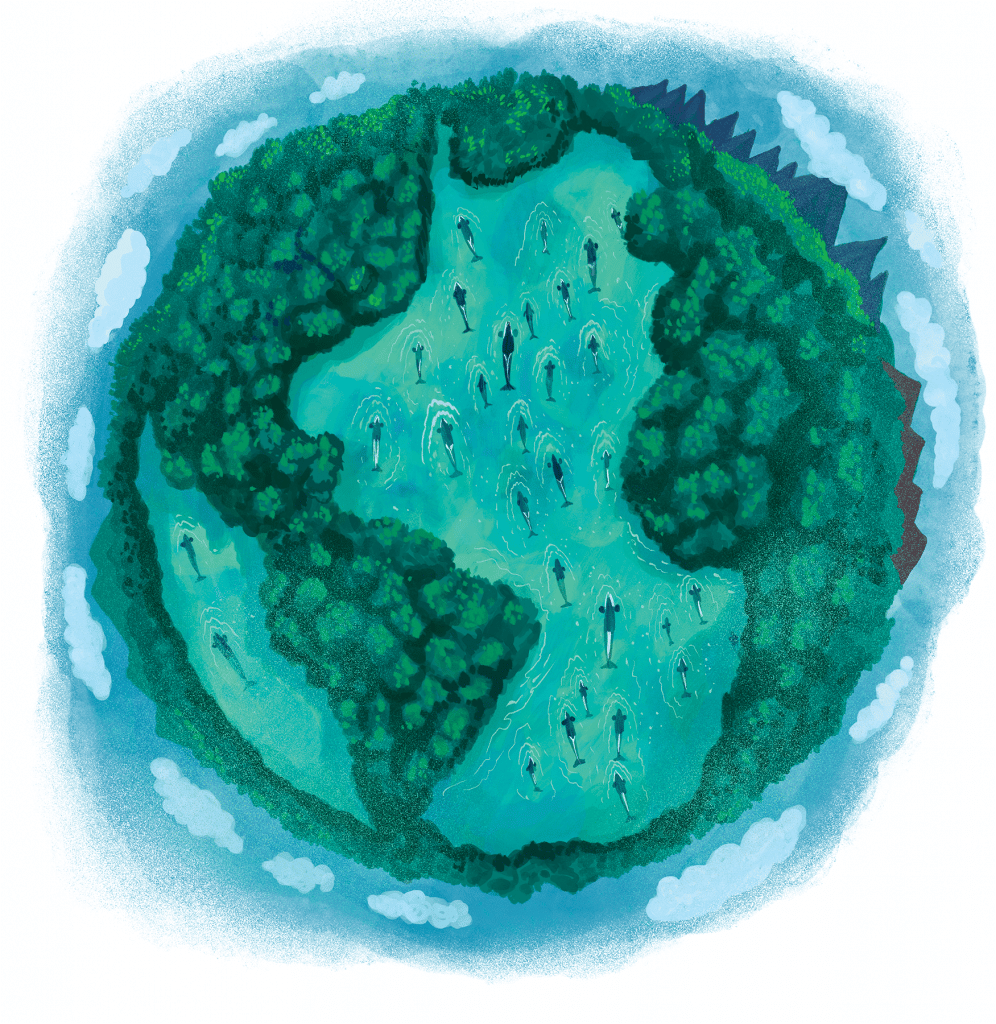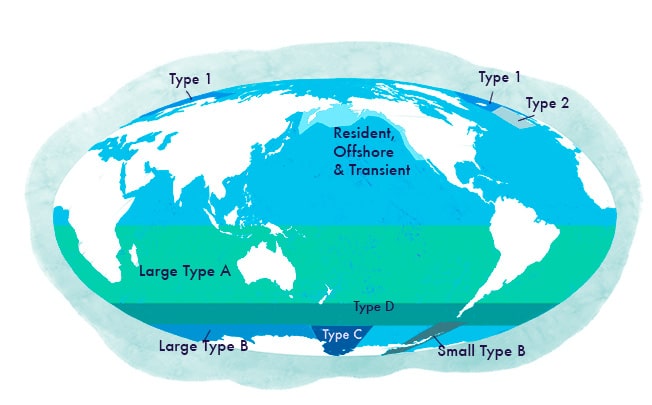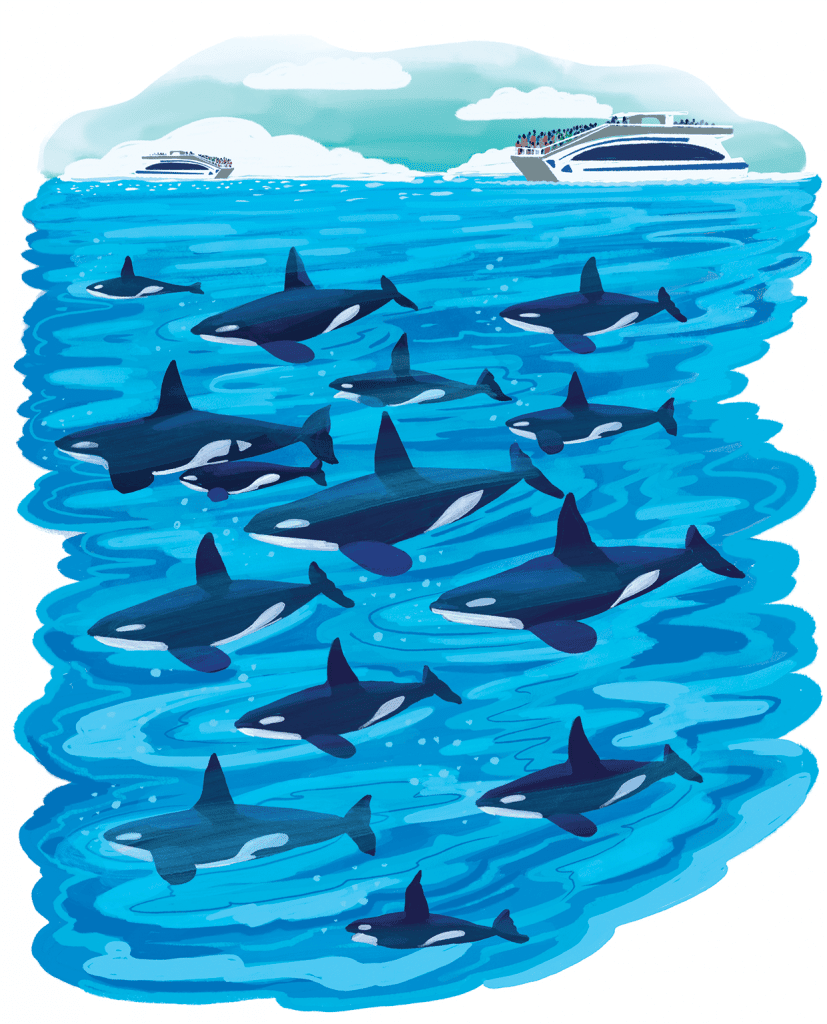Pppfff! I heard the breath at the same moment my eyes caught sight of the rounded black fin slicing through the water. Pppfff! Pppfff! Two more full breaths, each one causing my heart to skip a beat as my anticipation was finally met. I had heard hundreds of dolphin breaths before, but these were different. These belonged to ‘J pod’, an endangered population of Southern resident killer whales that live off the coast of Washington State, USA. A population that spends less time inland each year as local salmon stocks decline. Despite my frequent whale-watching trips and luck at seeing the growing number of transient killer whales around my home, it had been seven years since I had last seen any residents, making this sighting special.
Residents? Transients? How can some killer whales be endangered while others are thriving? And why does this matter—a killer whale is a killer whale, right? Well, let us start at the beginning
What’s in a name?
Killer whales are one of the most popular species of cetaceans, easily recognisable by their distinct black and white markings. Despite their name, they are actually the largest members of the dolphin family. Killer whales were first named by sailors who watched them hunt and prey on larger species. Even their scientific name, Orcinus orca, comes from the Roman god of the underworld, Orcus, reflecting their status as the ocean’s top predator. Killer whales are found in every ocean of the world, and are considered to be the most widely distributed mammal, after humans.
Currently classified as a single species, there are ten recognised ‘ecotypes’ of killer whales. Most people are familiar with the common taxonomic ranks; remember kingdom, phylum, class, order, family, genus, and species? While not one of the major scientific classifications, an ecotype is defined as individuals or groups of individuals that share ecological adaptations. Differences in ecology are key to specialisation, which can lead to observable physical differences, reproductive isolation, and eventually separate species.
As a single species all killer whales have relatively similar genetics and morphologies. However, upon closer inspection, different populations have their own prey preferences, language communication, and exhibit mating only with similar populations. Identifying these different ecotypes aids in the further classification of the species and helps our understanding of their ongoing evolution.

Studying evolution
Studying killer whales in the wild is extremely challenging due to their marine environment, so scientists are only just beginning to learn about the differences in killer whale populations and how they might have occurred. Understanding the role marine habitats play in relation to oceanic evolution is complex—unlike a terrestrial environment, there are fewer physical barriers and resources in the ocean. Additionally, genomic studies of killer whales have shown that there is a low genetic diversity between killer whale populations worldwide, perhaps due to a long history of overlapping habitats or slower mutation rates in cetaceans. Killer whale evolution is therefore best described by looking at historical geography, ecological differences, and their social culture.
Geography: In theory, killer whales can travel anywhere throughout the world’s oceans. As apex predators, they are found in the largest densities in polar and temperate regions where marine productivity is highest, although it is not uncommon to find populations in the tropics. Perhaps the greater amount of landmass in the northern hemisphere has played a part over time in separating or reconnecting different northern populations, while in the southern hemisphere greater competition and niche divergence (the process in which animals use the environment in different ways to avoid competition) might have developed as there is a higher percentage of ocean coverage.
Ecology: Due to this lack of geographic separation, differences between killer whale populations are largely thought to arise from specialisation in different prey types. Killer whales have an extremely diverse diet and have been observed preying on more than 140 different species, including over 50 types of mammals. By specialising in distinct food requirements, it is thought that different populations can avoid competition, as well as limit the energy needed to travel, learn, and hunt a wide variety of different prey items.
Culture: Killer whales form large family groups known as pods with highly complex social structures that centre around female members. In conjunction with prey specialisation, cultural transfer of such things as communication, hunting tactics, and pod size has contributed to the further divergence of varying populations. While mating is hard to observe in the wild, it is believed that different ecotypes are reproductively isolated. These social differences likely cause pre-copulation barriers as different cultural pods rarely physically mix, which over time may lead to reproductive isolation as populations continue to evolve farther apart.
Current classifications
Now we can start to see how and why different ecotypes have distinctive prey preferences, foraging behaviours, social cultures, geographic ranges, communication, physical characteristics, and to some degree, genetics. But what exactly makes each ecotype unique?

The Southern hemisphere has five ecotypes of killer whales: Antarctic type A, large type B, small type B, type C, and subantarctic type D.
Type A killer whales migrate between the tropics in the winter and Antarctica in the summer. They forage mostly on minke whales and elephant seals in ice-free, open water. Large type B, also called pack ice killer whales, have a dorsal cape and large eye patch. They can sometimes appear yellow due to local diatom algae buildup on their skin. These whales have a circumpolar range, feeding on ice seals in loose pack ice. They are known to wave-wash ice floes in groups to sweep their favourite prey, Weddell seals, into the water. Small type B killer whales also exhibit a yellow diatom film and a dorsal cape, but these whales have a narrower eye patch and a lighter grey colour than large type B. They frequent the Gerlache Strait on the western side of the Antarctic peninsula, feeding on penguins. Type C killer whales live deep in the pack ice of eastern Antarctica in the Ross Sea where they forage for fish. These are physically the smallest of all killer whale ecotypes. Finally, type D subantarctic killer whales are very rarely seen, and have only recently been described. They have large, round heads with tiny eye patches. Sightings have been circumglobal in subantarctic waters, often around islands.
In the Northern hemisphere are the other five ecotypes of killer whales: Type 1, type 2, offshore, transient, and resident.
Type 1 Eastern North Atlantic killer whales are smaller, and often seen in Norway foraging for fish such as herring, mackerel, and sharks. Type 2 Eastern North Atlantic killer whales are larger with a slanted eye patch. Rarely observed, this ecotype ranges in the North Atlantic, hunting other cetaceans. Offshore killer whales have faint saddle patches and range between Alaska and Southern California along the outer continental shelf, making sightings infrequent. Living in large family groups, they feed mainly on sharks, whose rough skin wears their teeth to the gum line. Transient Bigg’s killer whales are large with closed saddle patches, occurring in both offshore and coastal waters of the North Pacific. Favourite prey items include other mammals, such as seals, sea lions, otters, minke whales, and the calves of larger whale species. Resident killer whales exhibit open saddle patches with rounded dorsal fins. They forage for fish, oftentimes exclusively salmon, in coastal waters of the northeast Pacific. This is the most studied type of killer whale, with the Southern resident population being the most thoroughly researched group of marine mammals worldwide.

Why does this research matter for conservation?
Recent genetic studies strongly suggest that type A, B, C, and probably type D killer whales each be classified as their own species, with other ecotypes listed as subspecies until further research is conducted. Type 1 and 2 killer whales are closer to the beginning of the speciation process than the Antarctic populations but already show extensive differences. Other studies have found that despite overlapping ranges, transient and resident killer whales share no recent common ancestor, also suggesting distinct species. Understanding what makes different populations of killer whales unique can not only lead to a better understanding of their life histories, but also better conservation and management strategies.
Recent genetic studies strongly suggest that type A, B, C, and probably type D killer whales each be classified as their own species, with other ecotypes listed as subspecies until further research is conducted. Type 1 and 2 killer whales are closer to the beginning of the speciation process than the Antarctic populations but already show extensive differences. Other studies have found that despite overlapping ranges, transient and resident killer whales share no recent common ancestor, also suggesting distinct species. Understanding what makes different populations of killer whales unique can not only lead to a better understanding of their life histories, but also better conservation and management strategies.
The Southern resident population off the coast of Washington State is an excellent example of why this research is important for conservation. These whales are a large part of the culture and history in Washington, with over 500,000 people whale watching every year in their home range. However, the group has been steadily declining over the last several decades. Due to an abundant global population of killer whales and difficulty in determining separate species, the population was previously not eligible for protection under the Endangered Species Act of the United States or able to receive additional benefits.
Researchers then began looking into the evolutionary histories of killer whales for ways to differentiate groups from one another, and in 2005 the Southern residents were deemed a distinct population segment. This designation enabled them to be listed as endangered and paved the way for other killer whale populations to be evaluated. Further research has determined that anthropogenic threats such as a lack of food from dam development and overfishing, pollution, and increasing boat traffic are the major causes of the Southern residents’ decline. This has led to supplemental boating laws, citizen science programs, watershed and salmon restoration projects, and a state-wide Orca Task Force made up of different government agencies that work together to find solutions specifically to protect this population. These conservation actions, while directed at saving the killer whales, impact more than just the Southern residents and help the entire regional ecosystem.
These efforts would not be possible without the research and knowledge of killer whale ecotypes and speciation, and are inspiring change for killer whale research worldwide. Hopefully, the global diversity of killer whales can be preserved, as we are only just beginning to learn exactly what makes them unique.
Further Reading
Bruyn, P. J., C. A. Tosh and A. Terauds. 2012. Killer whale ecotypes: Is there a global model? Biological Reviews 88(1): 62–80. doi:10.1111/j.1469-185x.2012.00239.x
Hoelzel, A. R. and A. E. Moura. 2016. Killer whales differentiating in geographic sympatry facilitated by divergent behavioural traditions. Heredity 117(6): 481–482. doi:10.1038/hdy.2016.112
Leduc, R. G., K. M. Robertson and R. L. Pitman. 2008. Mitochondrial sequence divergence among Antarctic killer whale ecotypes is consistent with multiple species. Biology Letters 4(4): 426–429. doi:10.1098/ rsbl.2008.0168






